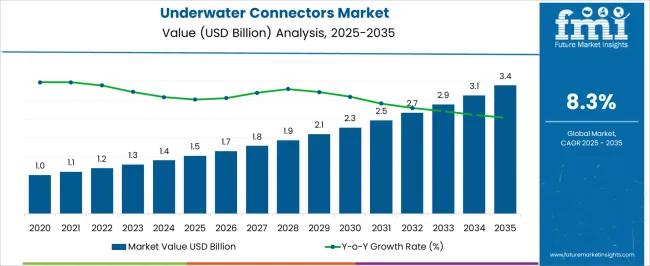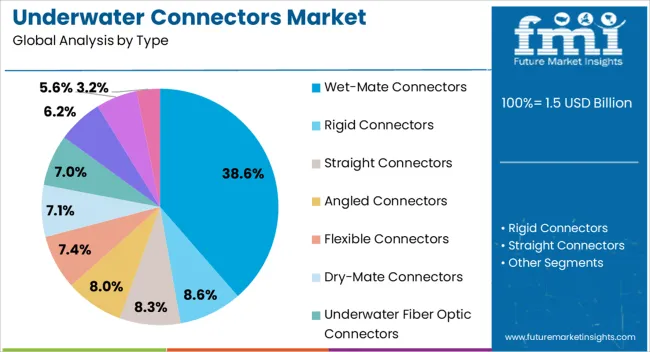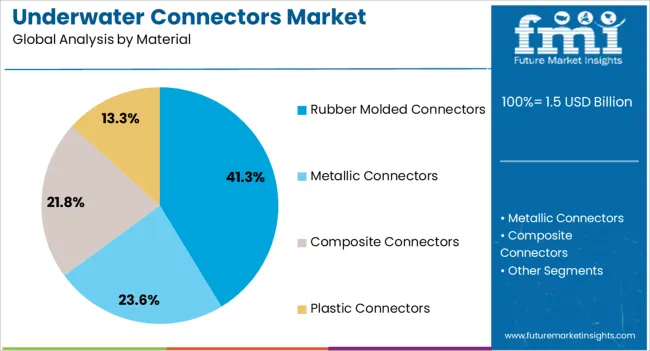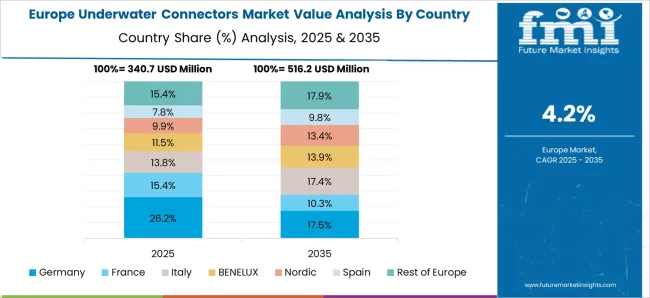The Underwater Connectors Market is estimated to be valued at USD 1.5 billion in 2025 and is projected to reach USD 3.4 billion by 2035, registering a compound annual growth rate (CAGR) of 8.3% over the forecast period. The market shows a distinctive acceleration and deceleration pattern over the forecast period, characterized by initial slow growth followed by an acceleration phase and then gradual deceleration towards the end. Between 2025 and 2027, the market experiences slow growth, expanding from USD 1.5 billion to USD 1.8 billion.
The initial phase exhibits a moderate acceleration, driven by increasing demand from underwater exploration, oil and gas, and renewable energy sectors, with annual growth rates of 6–7%. The market enters a more robust acceleration phase from 2027 to 2030, growing from USD 1.8 billion to USD 2.5 billion. During this period, the growth rate increases due to the higher adoption of underwater connectors in advanced technologies such as underwater robotics, communications, and autonomous underwater vehicles. The market sees an annual increase of approximately 9–10%, driven by expanding industrial applications. From 2030 to 2035, the market enters a deceleration phase, with growth slowing down slightly from USD 2.9 billion to USD 3.4 billion. The deceleration is attributed to market maturity and increasing competition, but demand for high-performance connectors in specialized applications continues to support steady growth.

| Metric | Value |
|---|---|
| Underwater Connectors Market Estimated Value in (2025 E) | USD 1.5 billion |
| Underwater Connectors Market Forecast Value in (2035 F) | USD 3.4 billion |
| Forecast CAGR (2025 to 2035) | 8.3% |
The underwater connectors market is undergoing notable expansion, primarily driven by the growing complexity and depth of offshore operations in energy, defense, and scientific exploration. The rising demand for deepwater oil and gas extraction, coupled with the expanding footprint of offshore wind farms and autonomous underwater vehicles, has necessitated the adoption of advanced subsea communication and power systems.
Software-defined control systems and real-time data transmission requirements have placed greater emphasis on connector durability, ease of maintenance, and electrical integrity under extreme hydrostatic pressures. Advancements in subsea robotics, inspection technologies, and sensor integration have further accelerated the development of compact, high-capacity connectors.
Increasing investment in underwater surveillance infrastructure and expanding marine renewable energy initiatives are supporting long-term market growth As underwater infrastructure becomes more digitized and operational uptime becomes critical, the reliance on precision-engineered connectors that can handle high data loads, power transmission, and long immersion cycles is expected to strengthen across both commercial and military applications.
The underwater connectors market is segmented by type, material, connection type, connector shape, application, and geographic regions. By type, underwater connectors market is divided into Wet-Mate Connectors, Rigid Connectors, Straight Connectors, Angled Connectors, Flexible Connectors, Dry-Mate Connectors, Underwater Fiber Optic Connectors, Single-mode Fiber Connectors, Multi-mode Fiber Connectors, and Hybrid Connectors. In terms of material, underwater connectors market is classified into Rubber Molded Connectors, Metallic Connectors, Composite Connectors, and Plastic Connectors. Based on connection type, underwater connectors market is segmented into Electrical Connectors, Optical Connectors, and Hybrid Connectors.
By connector shape, underwater connectors market is segmented into Circular Connectors and Rectangular Connectors. By application, underwater connectors market is segmented into Oil and Gas, Military and Defense, Telecommunications, Renewable Energy, and Others. Regionally, the underwater connectors industry is classified into North America, Latin America, Western Europe, Eastern Europe, Balkan & Baltic Countries, Russia & Belarus, Central Asia, East Asia, South Asia & Pacific, and the Middle East & Africa.

Wet mate connectors are expected to hold 38.6% of the total revenue share in the underwater connectors market in 2025, establishing them as the leading product type. The growth of this segment is being driven by their ability to perform reliable mating and demating operations while submerged, which significantly enhances operational efficiency in deepwater environments.
These connectors have become integral in applications requiring minimal surface intervention, particularly in offshore oil and gas installations, where uptime and ease of maintenance are critical. The ability to establish and re-establish secure connections under pressure, without the need for retrieval, has positioned them as a cost-effective and time-saving solution.
Continued innovation in sealing technology and corrosion-resistant materials has extended their operational lifespan and improved performance in high-salinity and high-pressure conditions. As subsea systems become more modular and require frequent connection cycles, wet mate connectors are expected to remain essential in ensuring uninterrupted data and power transmission.

Rubber molded connectors are projected to represent 41.3% of the total underwater connectors market revenue in 2025, making them the most dominant material type. This dominance can be attributed to their rugged construction, low production cost, and high adaptability in shallow to moderate depth applications. The segment has gained traction due to its excellent water sealing properties and resistance to harsh marine conditions.
The overmolded rubber body not only provides robust mechanical protection but also ensures consistent electrical performance over long durations of underwater exposure. These connectors have become widely adopted in oceanographic instruments, subsea lighting, and remotely operated vehicle systems due to their simplicity and dependability.
As the need for scalable and easily deployable underwater equipment continues to rise, rubber molded connectors are being favored for their balance of performance, affordability, and versatility. Their wide usage across commercial and scientific applications further solidifies their position as a foundational component in subsea connectivity.

Electrical connectors are expected to account for 52.7% of the overall underwater connectors market revenue in 2025, positioning them as the leading connection type. Their widespread adoption is being fueled by the increasing need for reliable power and signal transmission in subsea infrastructure, including monitoring stations, subsea control modules, and marine renewable energy systems. Electrical connectors have been preferred for their capability to support high-speed data communication, consistent power delivery, and compatibility with both analog and digital equipment.
The rising complexity of underwater systems has necessitated compact, high-density electrical connectors that can withstand extreme environmental conditions while maintaining performance standards. Advances in insulation materials, contact plating, and sealing techniques have enhanced connector resilience and reduced maintenance cycles.
The growing demand for unmanned underwater vehicles and continuous data logging systems has further elevated the importance of secure electrical connectivity. With subsea digitization becoming a core operational strategy, electrical connectors are expected to play a pivotal role in ensuring connectivity across critical underwater assets.
The underwater connectors market is experiencing significant growth, driven by the increasing demand for reliable and durable interconnect solutions in subsea applications. These connectors are essential for various industries, including oil and gas, marine research, defense, and telecommunications, where they facilitate the transmission of power, data, and signals in challenging underwater environments. Advancements in materials and technologies have led to the development of connectors that offer enhanced performance, corrosion resistance, and the ability to withstand high-pressure conditions. As industries continue to explore and utilize underwater resources, the need for sophisticated connector solutions is expected to rise, further propelling market growth.
One of the primary drivers is the expansion of offshore oil and gas exploration, where reliable interconnect solutions are essential for deep-sea drilling and resource extraction. Additionally, the growth in marine research and environmental monitoring is increasing the demand for underwater connectors in research equipment, sensors, and monitoring systems. The rise of subsea telecommunications networks, especially with the expansion of global 5G infrastructure, is another key factor, as it requires robust connectors for data transmission. Moreover, advancements in underwater robotics and autonomous systems, such as unmanned underwater vehicles (UUVs) and remotely operated vehicles (ROVs), are driving the demand for specialized connectors in various subsea applications.
The development of underwater connectors faces several challenges. The harsh operating conditions, including extreme pressures, corrosive saltwater, and temperature fluctuations, require connectors to be highly durable and resistant to degradation, adding complexity to their design and manufacturing. High manufacturing costs, driven by the need for specialized materials and precision engineering, are another challenge, making these connectors more expensive than traditional connectors used in land-based applications. Additionally, the integration of advanced technologies, such as fiber optics and hybrid connectors, adds technological complexity to the design process. Compliance with strict industry standards and regulations for safety, environmental impact, and performance also increases production costs and manufacturing challenges.
The underwater connectors market offers significant opportunities for innovation and growth. One of the key opportunities is the development of hybrid connectors that integrate electrical, optical, and data communication capabilities, which would enhance the versatility and efficiency of subsea systems. Advancements in materials science, including the use of corrosion-resistant alloys and composites, can lead to the creation of more durable connectors suitable for harsher underwater environments. Moreover, customization of connectors for specific applications in industries like defense, telecommunications, and renewable energy can open new market segments. The growing investment in underwater infrastructure in emerging markets, particularly in Asia-Pacific and Latin America, presents substantial opportunities for market expansion.
The underwater connectors market is being shaped by several key trends. Miniaturization is driving the demand for smaller, more compact connectors that can be integrated into tighter spaces, offering greater flexibility in subsea system design. The development of wireless and inductive coupling technologies is also a notable trend, allowing for contactless power and data transmission, which reduces wear and tear on connectors and improves their reliability. Smart connectors with integrated sensors are becoming increasingly popular, enabling real-time monitoring of system performance and environmental conditions, which helps improve maintenance and operational efficiency. Additionally, there is a growing focus on sustainability, with manufacturers exploring eco-friendly materials and production processes for underwater connectors to reduce their environmental impact. These trends will continue to influence the market's future development.
| Country | CAGR |
|---|---|
| China | 11.2% |
| India | 10.4% |
| Germany | 9.5% |
| France | 8.7% |
| UK | 7.9% |
| USA | 7.1% |
| Brazil | 6.2% |
The global underwater connectors market is projected to grow at a CAGR of 8.3% from 2025 to 2035. Among the key markets, China leads with a growth rate of 11.2%, followed by India at 10.4%, and Germany at 9.5%. The United Kingdom and the United States record more moderate growth rates of 7.9% and 7.1%, respectively. This growth is driven by the increasing demand for underwater connectors in industries such as offshore oil and gas, renewable energy, and subsea communications. Emerging markets like China and India are seeing faster growth due to their expanding marine industries and offshore energy projects, while developed markets like the USA and the UK experience steady demand due to their mature offshore infrastructure. The analysis includes over 40+ countries, with the leading markets detailed below.
China is expected to lead the global underwater connectors market, with a projected growth rate of 11.2% CAGR from 2025 to 2035. The country’s rapid advancements in offshore energy, particularly in subsea oil and gas exploration, and expanding marine industries are key drivers of this growth. China’s rising investments in offshore infrastructure and renewable energy projects, such as offshore wind farms, are significantly increasing demand for reliable underwater connectors. The growth of the country’s maritime industry and increasing underwater robotics applications further contribute to market expansion. With ongoing investments in marine technology, China is set to remain a leading player in the underwater connectors market, with continued innovations supporting its growth trajectory.
The underwater connectors market in India is projected to experience strong growth, with a CAGR of 10.4% from 2025 to 2035. The country’s growing offshore oil and gas industry and expanding marine renewable energy sector are major drivers of demand for underwater connectors. The Indian government’s focus on expanding its maritime infrastructure and offshore energy capabilities will continue to fuel the need for reliable underwater connections. Additionally, the growing interest in underwater robotics and subsea automation technologies will further support the market’s growth. As India continues to invest in these sectors, the underwater connectors market is expected to grow significantly, offering new opportunities for innovation and technology development.

Demand for underwater connectors in Germany is expected to grow steadily, with a projected CAGR of 9.5% from 2025 to 2035. The country’s strong presence in offshore wind energy projects, subsea communications, and underwater robotics industries is driving demand for advanced underwater connectors. As Germany continues to invest in renewable energy and marine technology, the need for reliable and high-performance underwater connections will rise. Germany’s focus on industrial automation and advancements in deep-sea exploration is expected to contribute significantly to market growth. With technological innovations and growing demand for marine infrastructure, Germany’s underwater connectors market will experience steady expansion.
The underwater connectors market in the United Kingdom is expected to grow at a CAGR of 7.9% from 2025 to 2035. The UK.’s demand for underwater connectors is driven by advancements in offshore energy, subsea communication systems, and marine renewable energy projects. The country’s investments in offshore wind farms and subsea cable networks are key contributors to market expansion. The rise in deep-sea exploration and the growing focus on underwater robotics applications are further fueling demand for underwater connectors. As the UK continues to innovate in marine and renewable energy technologies, the underwater connectors market is expected to see steady growth.
The United States’ underwater connectors market is projected to grow at a CAGR of 7.1% from 2025 to 2035. The country’s offshore oil and gas industry, alongside its expanding focus on marine renewable energy, is a major driver of demand for underwater connectors. The USA is increasing its investments in offshore wind farms, subsea communications, and deep-sea exploration technologies, all of which require advanced and reliable underwater connectors. The emphasis on underwater robotics and autonomous marine systems is expected to continue driving market growth. As the USA enhances its offshore infrastructure, the underwater connectors market is poised for steady expansion.

Amphenol Corporation dominates the market, providing high-performance underwater connectors for industries like marine, oil and gas, and subsea telecommunications. Their connectors are known for their robustness and reliability in deep-sea applications. Eaton Corporation is another key player, known for durable connectors that ensure consistent power and data transmission in challenging underwater conditions, particularly in offshore and energy sectors. Baker Hughes (GE Company LLC.) plays a significant role by offering specialized underwater connectors for offshore oil and gas applications. These connectors are designed to perform in high-pressure and high-temperature environments, ensuring long-term performance in subsea oil exploration. Fischer Connectors SA is recognized for its versatile connector solutions, especially in underwater robotics, instrumentation, and defense applications. Their connectors offer excellent durability and functionality in extreme conditions.
BIRNS, Inc. is renowned for its corrosion-resistant underwater connectors, primarily used in marine and nuclear applications, ensuring reliable connections in highly corrosive environments. Birns Aquamate LLC provides environmentally sealed connectors for commercial and military use, focusing on strong performance in subsea systems. C.R. Encapsulation Limited specializes in encapsulation and sealing technologies for underwater connectors, delivering waterproof, long-lasting solutions for underwater exploration and subsea services. These players are focused on continuous innovation to meet the increasing demand for reliable, high-performance underwater connectors used in deep-water exploration, offshore energy production, and marine research.
| Item | Value |
|---|---|
| Quantitative Units | USD 1.5 Billion |
| Type | Wet-Mate Connectors, Rigid Connectors, Straight Connectors, Angled Connectors, Flexible Connectors, Dry-Mate Connectors, Underwater Fiber Optic Connectors, Single-mode Fiber Connectors, Multi-mode Fiber Connectors, and Hybrid Connectors |
| Material | Rubber Molded Connectors, Metallic Connectors, Composite Connectors, and Plastic Connectors |
| Connection Type | Electrical Connectors, Optical Connectors, and Hybrid Connectors |
| Connector Shape | Circular Connectors and Rectangular Connectors |
| Application | Oil and Gas, Military and Defense, Telecommunications, Renewable Energy, and Others |
| Regions Covered | North America, Europe, Asia-Pacific, Latin America, Middle East & Africa |
| Country Covered | United States, Canada, Germany, France, United Kingdom, China, Japan, India, Brazil, South Africa |
| Key Companies Profiled | Amphenol Corporation, Eaton Corporation, Baker Hughes (GE Company LLC.), Fischer Connectors SA, BIRNS, Inc., Birns Aquamate LLC., and C.R. Encapsulation Limited |
| Additional Attributes | Dollar sales by product type (subsea connectors, waterproof connectors, hermetically sealed connectors) and end-use segments (oil and gas, marine research, defense, telecommunications). Demand dynamics are driven by the increasing need for reliable underwater communication systems, growth in offshore oil and gas exploration, and expanding marine robotics applications. Regional trends show strong growth in North America, Europe, and Asia-Pacific, driven by increased investments in subsea oil exploration, underwater research, and underwater robotics. |
The global underwater connectors market is estimated to be valued at USD 1.5 billion in 2025.
The market size for the underwater connectors market is projected to reach USD 3.4 billion by 2035.
The underwater connectors market is expected to grow at a 8.3% CAGR between 2025 and 2035.
The key product types in underwater connectors market are wet-mate connectors, rigid connectors, straight connectors, angled connectors, flexible connectors, dry-mate connectors, underwater fiber optic connectors, single-mode fiber connectors, multi-mode fiber connectors and hybrid connectors.
In terms of material, rubber molded connectors segment to command 41.3% share in the underwater connectors market in 2025.






Full Research Suite comprises of:
Market outlook & trends analysis
Interviews & case studies
Strategic recommendations
Vendor profiles & capabilities analysis
5-year forecasts
8 regions and 60+ country-level data splits
Market segment data splits
12 months of continuous data updates
DELIVERED AS:
PDF EXCEL ONLINE
Underwater Light Market Size and Share Forecast Outlook 2025 to 2035
Underwater Hotel Market Forecast and Outlook 2025 to 2035
Underwater Welding Consumable Market Size and Share Forecast Outlook 2025 to 2035
Underwater Modems Market Size and Share Forecast Outlook 2025 to 2035
Underwater Bikes Market Size and Share Forecast Outlook 2025 to 2035
Underwater Pelletizing Market Size and Share Forecast Outlook 2025 to 2035
Underwater Camera Market Size and Share Forecast Outlook 2025 to 2035
Underwater Acoustic Communication Market Growth - Trends & Forecast 2025 to 2035
Underwater Welding Equipment Market Growth – Trends & Forecast 2024-2034
RF Connectors Market Size and Share Forecast Outlook 2025 to 2035
SMP Connectors Market Size and Share Forecast Outlook 2025 to 2035
Gas Connectors and Gas Hoses Market - Safety, Demand & Market Outlook 2025 to 2035
Cable Connectors and Adapters Market Analysis by Application, Product, Type and Region: Forecast from 2025 to 2035
Automotive Connectors Market Size and Share Forecast Outlook 2025 to 2035
Small Bore Connectors Market Analysis - Size, Growth, and Forecast 2025 to 2035
Automotive Connectors Global Market
Fiber Optic Connectors Market Growth – Trends & Forecast through 2034
Non-Magnetic Connectors Market Size and Share Forecast Outlook 2025 to 2035
Multi Coaxial Connectors Market - Growth & Forecast 2025 to 2035
Automotive Data Connectors Market Analysis - Size, Share, & Forecast Outlook 2025 to 2035

Thank you!
You will receive an email from our Business Development Manager. Please be sure to check your SPAM/JUNK folder too.
Chat With
MaRIA